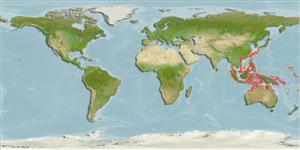Environment: milieu / climate zone / depth range / distribution range
Ecologie
marien rifbewoner; diepte 40 - 130 m (Ref. 5222). Tropical; 34°N - 20°S, 92°E - 177°W
Western Pacific: Andaman Sea to southern Japan, Taiwan, China, Philippines, Viet Nam, Malaysia, Thailand, Indonesia, New Guinea, the Arafura Sea (Ref. 9819), northwestern Australia, and Fiji.
Grootte / Gewicht / Leeftijd
Maturity: Lm ? range ? - ? cm
Max length : 50.0 cm TL mannelijk / geslacht onbekend; (Ref. 5222)
Dorsale stekels (totaal): 11; Dorsale zachte stralen (totaal): 15-16; Anale stekels 3; Anale zachte stralen: 8. This species is distinguished by the following characters: body depth less than head length, 2.5-3.0 times in SL; large head length 2.1-2.4 times in SL; rounded preopercle with 3-6 enlarged serrae at the angle; upper edge of operculum slightly convex; midside of lower jaw with 2 rows of teeth; gill rakers of first gill arch 8 + 14-16 = 22-24; scaly maxilla, reaching about vertical at rear edge of eye; pectoral and pelvic fin length are equal, 1.7-2.3 times in head length; ctenoid lateral body scales, few auxiliary scales in adults. Colour of head, body and median fins are pale grey; 5 broad dark brown bars, first 2 extending into the spinous part of dorsal fin, 3rd and 4th bars extending into the soft dorsal and anal fins, 5th dark bar at the base of the caudal fin; edges of dorsal parts of body bars with small black spots; nape with dark brown saddle blotch, small black spots mainly along edge of the blotch; cheeks, snout, interorbital area, jaws and chest mostly dark brown, with 2-3 white bands radiating from the eye; irregular black bar on the middle of the caudal fin; yellow maxillary groove; small juveniles (6 cm SL) white, with black bars on body as described for adults, the fins pale yellow with small black spots (Ref. 39231, 89707).
This species is usually found on offshore coral and rocky reefs. A popular and commercially important species in Hong Kong, but not in Singapore. Caught with hand lines and sold fresh (Ref. 39231).
Levenscyclus en paargedrag
Maturiteit | Voortplanting | Paaien | Eieren | Fecunditeit | Larven
Heemstra, P.C. and J.E. Randall, 1993. FAO Species Catalogue. Vol. 16. Groupers of the world (family Serranidae, subfamily Epinephelinae). An annotated and illustrated catalogue of the grouper, rockcod, hind, coral grouper and lyretail species known to date. Rome: FAO. FAO Fish. Synop. 125(16):382 p. (Ref. 5222)
Status op de Rode Lijst van het IUCN (Ref. 130435)
Gevaar voor de mens
Harmless
Gebruik door de mens
Visserij: van minder commercieel belang
Meer informatie
Lokale namenSynoniemenMetabolismePredatorenEcotoxicologieVoortplantingMaturiteitPaaienPaaiaggregatiesFecunditeitEierenOntwikkeling van de eieren
ReferentiesAquacultuurAquacultuurprofielKweeklijnenGeneticaElectrophoresesErfelijkheidZiektesVerwerkingNutrientsMassaconversie
Tools
Speciale rapporten
Download XML
Internetbronnen
Estimates based on models
Preferred temperature (Ref.
123201): 20.2 - 27.6, mean 23.9 °C (based on 136 cells).
Fylogenetische diversiteitsindex (Ref.
82804): PD
50 = 0.5000 [Uniqueness, from 0.5 = low to 2.0 = high].
Bayesian length-weight: a=0.01175 (0.00571 - 0.02419), b=3.04 (2.88 - 3.20), in cm total length, based on LWR estimates for this Genus-body shape (Ref.
93245).
Trofisch niveau (Ref.
69278): 3.8 ±0.5 se; based on size and trophs of closest relatives
Weerstandsvermogen (Ref.
120179): Gemiddeld, minimale populatieverdubbelingstijd 1,4-4,4 jaar (Preliminary K or Fecundity.).
Fishing Vulnerability (Ref.
59153): Moderate vulnerability (40 of 100).
Nutrients (Ref.
124155): Calcium = 27.2 [13.3, 56.6] mg/100g; Iron = 0.481 [0.260, 0.967] mg/100g; Protein = 18.5 [16.9, 19.8] %; Omega3 = 0.134 [0.086, 0.211] g/100g; Selenium = 40 [24, 68] μg/100g; VitaminA = 186 [54, 642] μg/100g; Zinc = 1.26 [0.89, 1.76] mg/100g (wet weight);
